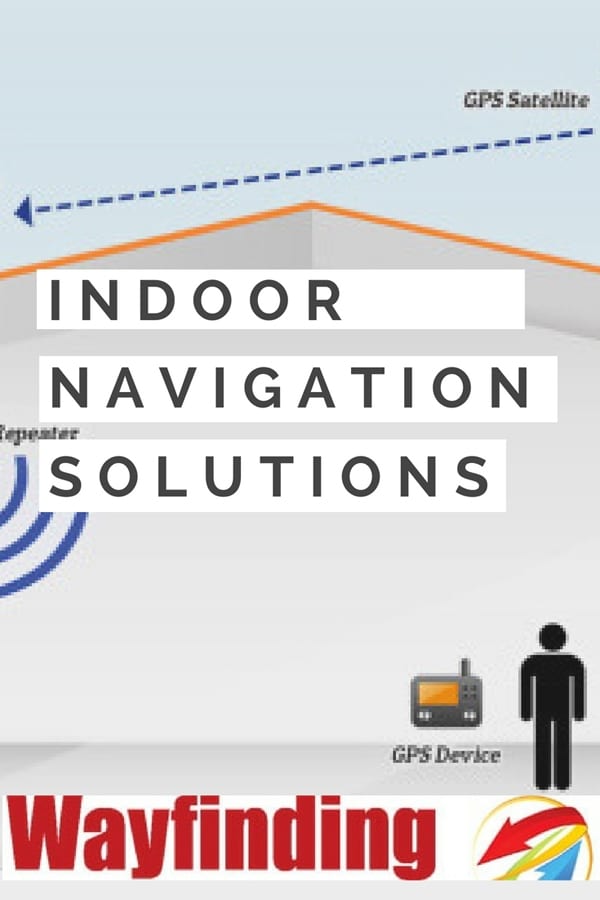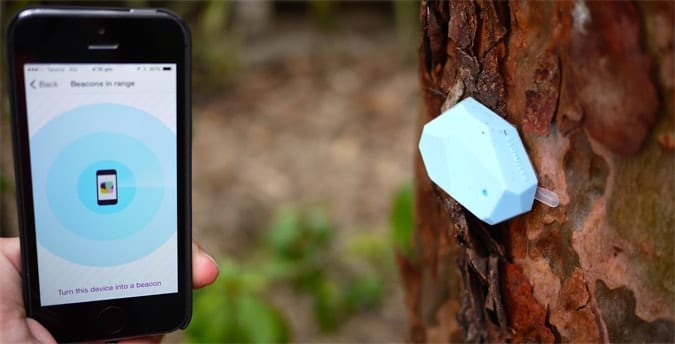Design a Map for Wayfinding Using Graphics
Last Updated on March 6, 2020
Given the ease with which GPS (Global Positioning Systems) are available for us outdoors (such as on mobile phones), one might naturally assume that indoor GPS is also easily possible, for indoor navigation.
Unfortunately, though, the GPS signals cannot work indoors (unless repeaters are used), the signals unable to penetrate walls and the architecture in general. Using GPS will either not work at all or tends to be wholly unreliable and, in effect, unusable. So what are the solutions and tools that are presently available for indoor navigation? Some answers follow below!

iBeacons
One of the most effective solutions at this time and that is being used by some businesses, including Gatwick Airport, are iBeacons.
These are very simple devices that, in effect, simply act like a lighthouse to identify its own position. The beacons do not hold data and do little except for their key task, to send out a signal to say, "Here I am.
This is my position". These beacon devices normally use low energy (BLE) and have Bluetooth antennas and technically speaking, even an iPad or iPhone could be used as an iBeacon. These beacons willnot normally be internet-connected, but instead, relay data across the aforementioned Bluetooth connection.
As highlighted in a recent report, some companies are now using iBeacons as a tool for mapping out very large indoor spaces, such as airports.
The main barrier to entry for many businesses to go down this route though is the large capital outlay needed to buy the hundreds (even thousands) of beacons in order to fully map an area such as a large international airport. Gatwick Airport, in their recent installation of iBeacons, for example, are said to have spent tens of thousands of pounds on the beacons alone.
Once installed, these beacons have an accuracy of within 3 meters and there are some interesting (and one might also say controversial, given the way in which so many data on our location might be used) uses for indoor mapping via beacons. An airport, for example, can begin to use these beacons signals to interact with your own mobile signal. Using airports as an example, this could guide:
- Augmented reality on your mobile device (meaning you could, for example, have a map on your phone which uses Blue Dot technology to show you the route to your departure gate by showing a path of blue dots that you follow on your mobile device screen).
- Enable the airport to monitor users' locations and use this for commercial purposes, such as to push certain advertising messages onto certain digital advertising boards in the location.
- The possibilities for airports (and other locations) in terms of data collection are significant including the chance topush data to your phone if you are in a specific location. A retail outlet or a restaurant, for example, can push specific targeted offers to you on your phone, for example, as you pass by their location. The good news at the moment is that you do have to opt-in for such information being pushed to your device, i.e. by installing the airport app.
WPS (Wi-Fi Positioning)
Another option is to use Wi-Fi positioning (WPS). The problem with WPS though is that the positioning is less accurate than beacons, with WPS tending to provide a 5-15 meter accuracy range. Furthermore, WiFi signals can sometimes get lost or be weak and thus WPS is also less reliable versus beacons, in terms of the signal.
Despite the inaccuracies of WPS as mentioned above, the great benefit is that existing WiFi infrastructure can be used and many large locations do already have this in place or at least in part. The reach of WiFi signals can also be quite long often reaching beyond 100 meters.
Individual Company Solutions
There are a number of companies who are vying to be the leader in the indoor positioning and mapping sector. It is a highly competitive field and significant investment goes into many of these solutions in the research and development (R&D) stages. Some of the best solutions at this time are highlighted below:
IndoorAtlas (Magnetic Positioning)
One of the leading companies in this wayfinding battle for indoor mapping is IndoorAtlas, a Finnish based company who have created a hybrid solution, in that it is able to combine a seamless application for wayfinding in and between both indoor and outdoor spaces.
The need for a hybrid solution that creates a seamless solution is important in navigation because we, as users, walk between both environments and it is not ideal to have to change between solutions, the moment one walks outside or inside.
IndoorAtlas uses magnetic positioning and this is a very clever (in my opinion) concept in that it uses the magnetic footprint of the building itself.
The building materials and spaces and so on will all affect the magnetic pattern (or fingerprint) of the building itself and, by talking digital copies of the building's magnetic field, it becomes possible to understand the locations within the magnetic field.
From the image below, we can see, for example, the unique fingerprint of the building because of its unique magnetic pattern.
This technique of magnetic fields for navigation is in fact exactly the same technique that birds are thought to use for migration and for finding their way across the world and with a distinct level of accuracy.

The accuracy of magnetic mapping is to within 2 meters, thus making it one of the most accurate solutions presently on the market.
Using GPS Repeaters for Indoor Navigation
A company such as FalTech GPS (based in the UK) uses GPS repeaters to re-direct GPS signals to provide a signal indoors (see diagram below) to enable indoor navigation.
The accuracy of the signal is less important in the FalTech solution because this indoor GPS system is aimed more at those who, for example, need to test, use, or operate GPS devices indoors.
For example, a vehicle manufacturer using GPS repeaters from FalTech can test GPS and infotainment systems on the production line, without having to drive the car outdoors and risk it getting scratched and losing time in the production cycle.
Likewise, the repeaters can aid retail outlets who wish to showcase GPS related products (i.e. satnav) from indoor locations.
FalTech has just reached its fifth anniversary since launch in 2012. In that time they have developed a client base in a number of sectors and are building a good reputation.
One sector that FalTech operates in is known as "blue light", with several hundred repeaters installed in fire stations across the UK.
FalTech's technology appears to be more aimed at determining the location of specific users/devices such as fire appliances in emergency situations. Certainly, this technology has vital uses and is worthy of consideration.
The Faltech repeaters emit a very wide beam – almost 180 degrees wide. It can be ceiling mounted, so at a height of 10 meters and it would easily provide coverage in a hangar of 50 meters x 50 meters.
If wall-mounted it can beam a signal horizontally across space up to about 50 meters in clear space, i.e. with no physical obstructions to affect the line of sight.

One thing to be aware of is that, wherever you are within the coverage area, you will always receive the same positional coordinates – those of the outdoor antenna. As mentioned before though, these repeaters are more suited for testing or showcasing GPS products indoors rather than intended as a tool for precise indoor mapping.
Other Useful Articles on Indoor Navigation
- Indoor navigation case studies – by wrld3d.com
- Insoft indoor navigation solutions – and their wayfinding app
- Here.com navigation and wayfinding indoors.
Dr Paul Symonds has a PhD in Wayfinding from Cardiff Metropolitan University in the UK. Paul works with the signage industry, airports and other locations providing wayfinding audits, consultancy and training.
Design a Map for Wayfinding Using Graphics
Source: https://www.travelwayfinding.com/indoor-navigation-technology/
ارسال یک نظر for "Design a Map for Wayfinding Using Graphics"